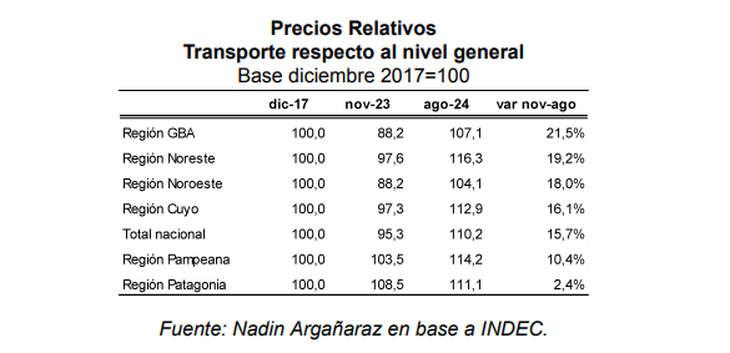If in the first six months of the year it can be said that the The increase in food and beverage prices was the driving force behind inflation, now it is the updating of tariffs and transportation. According to a report from the Argentine Institute of Fiscal Analysis (IARAF), In the case of the price of housing, water, electricity, gas and other fuels, the relative price grew by 30% this year, while that of transport grew by 15.7%.
The relative value of a good is measured in relation to the price of another good. The report takes as a basis base the value 100 of 2017 and from there make a comparisonBasically, the index shows that the price of these items was cheaper than that of tradable goods and that now this relationship is being reversed.
The report says that “in the case of Housing, water, electricity, gas and other fuelss, the relative price at national level was 46.4% lower in November than in December 2017 and in August it remains down 30.1%.”
relative-prices-rest.png
“Between November 2023 and August 2024, the relative price rose by 30.3%,” the study notes. But the fact is that it is not rising equally across the country.
The relative price of public services increased the most in the northwest region, with a rise of 50%, followed by the northeast region with an increase of 39.3%.
At the other extreme, where the relative price of public services rose the least was in the Greater Buenos Aires, with 26.6%, followed by Patagonia with 28.3%.
“Broadly speaking, in the region where the relative price increased the least, it did so by almost half of that of the region where the price increased the most,” explains IARAF.
On the other hand, The Pampas region is the one that still has the relative price furthest from December 2017, Specifically, 37.3%. At the other extreme is the Northeast region, with a relative price only 6% below the reference value.
The price of transportation
On the other hand, in relation to transport, the relative price of Nationally, the figure was 4.7% lower in November than in December 2017 and in August is 10.2% higher. Between November 2023 and August 2024, the relative price rose by 15.7%.
“Where the relative price of transport increased the most was in the region of Greater Buenos Aires, with an increase of 21.5%. followed by the northeast region with an increase of 19.2%,” the report says.
relative-prices-transport.png

At the other extreme, where less The relative price of transport rose in the Patagonia region, by 2.4%. The Pampas region follows with 10.4%. Broadly speaking, in the region where the relative price increased the least, almost a tenth of the region where the price increased the most did so.
The report says that “the new national government began a process of reducing subsidies to energy and transportation” whose downside is “is a higher rate.”
“Taking November 2023 as a reference, it can be seen that until August the Regulated Price Index (CPI) grew by 221.3% and the Core CPI grew by 134.0% (13.8% and 9.9% monthly average, respectively). This dynamic continued in August (5.9% regulated CPI and 4.1% core CPI). The result of this process is an increase in the relative price of regulated goods and services,” the study explains.
Source: Ambito




